Aurea Technology to show self-contained quantum optics instrument building blocks at SPIE Photonics West 2019
SPD_OEM photon-counting module. (Image: Aurea technology) Quantum optics and photonics, usually seen today in the form of complex experiments assembled on an optical table, are touted by some as computing's future. Quantum optics also are relevant to quantum cryptography, tomography, and fundamental physics experiments.Aurea Technology (Besancon, France) is making things easier for those researchers who are assembling complex experiments; Aurea has developed a comprehensive suite of the essential quantum optics instruments for novel quantum optical systems, and will be exhibiting them at booth #959 at SPIE Photonics West 2019 (San Francisco, CA; 2-7 Feb. 2019). The self-contained quantum optics building-blocks offered by Aurea technology include: --The SPD_OEM, a sensitive, low-noise, compact single photon counting module designed for the detection of ultra-low-levels of light down to the single photon regime. This type of device allows sources such as twin-entangled-photon sources to be characterized using time-correlation techniques. --The LYNXEA is an all-in-one time-resolved single photon counting module that integrates two independent single photon counters and the timing electronics. In this device, the two independent photon detectors have been paired during manufacturing; as a result, the two paired detectors have similar dark-count rate and quantum efficiency. --The CHRONOXEA, which is a newly introduced timing-resolved module that provides four channel inputs with timing resolution in the picosecond range. --The TPS, which is a high-brightness twin photon source that emits parallel- or orthogonal-polarization twin photon pairs at telecom wavelengths of 810, 1310, or 1550 nm. Entangled photons are a promising way for demonstrating quantum physics principles and new quantum information applications. For example, entangled photons allow the development of quantum-key distribution (QKD) protocols over distances of a few hundred kilometers. In biological imaging applications, entangled-photon light sources can lead to dispersion-free measurements. For more info, see www.aureatechnology.com. Source: Aurea Technology
